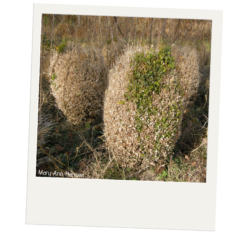
Other names: Boxwood blight, Calonectria pseudonavitulata (Prev: Cylindrocladium pseudonaviculatum, Cylindrocladium buxicola)
Where did it come from?
Boxwood blight was first discovered on the east coast in 2011. It overwinters in leaf litter and on infected plants and can be spread by moving infected material.
Why is it invasive?
It causes dark leaf spots, white sporulation on the plant, and cankers on the stems. Plants lose their leaves within days of onset of symptoms. The blight can eventually kill some plants.
How do you prevent its spread?
Use resistant varieties from reputable producers. Avoid holiday decorations containing boxwood. Minimize transferring the disease to new plants by taking precautions like not cutting wet boxwood and not composting infected plants.
Resources:
♦ Watch for potential new boxwood pest
♦ Boxwood blight found in Indiana
Seen it? Report it! Through the app, online, by email, or by phone (1-866-663-9684).
Image credit: Mary Ann Hansen, Virginia Polytechnic Institute and State University, Bugwood.org